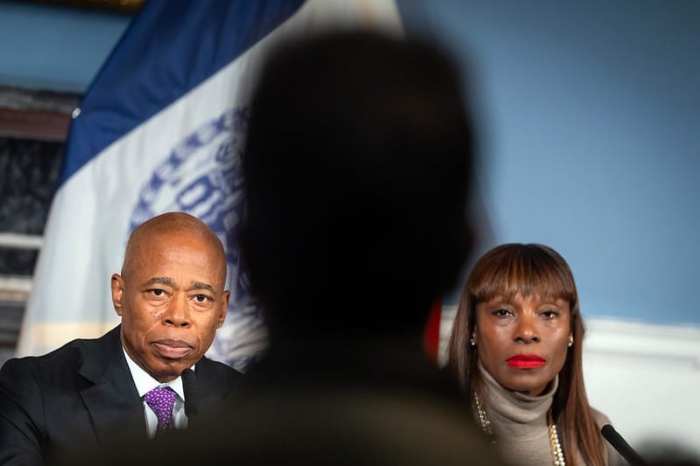
Activists have long criticized the mayor’s office for the plodding pace of storm-proofing work in the wake of superstorm Sandy.
Thursday, Comptroller Scott Stringer released a report validating their concerns.
The city has spent only 54 percent of the $14.7 billion in federal money set aside for Sandy repair and resiliency projects, according to Stringer’s analysis of data through March 31. Stringer said the city must work through the delays because some of the money has an expiration date in 3.5 years and because many coastal sections of the city are not ready for another deluge on the scale of the 2012 storm.
"Scientists estimate that Sandy-like flooding can be a one in five year event by midcentury. This is an emergency," Stringer said at a news conference at the South Street Seaport.

After Sandy, the federal government approved in 2013 a $10.5 billion package from FEMA for public infrastructure, recovery and resiliency work in the city and $4.2 billion from the U.S. Department of Housing and Urban Development for work targeting homes and businesses. The HUD money has an expenditure deadline of Sept. 30, 2022.
Stringer’s report highlighted the discrepancy in spending among city agencies. The Police Department has used about 80 percent of its $285 million in FEMA funds, whereas the municipal health care system, Health + Hospitals, has taken advantage of just 20 percent of the $1.9 billion earmarked for it, the report found.
The comptroller said the city has been concentrating on protecting lower Manhattan, at the expense of other vulnerable communities like Coney Island, where none of the $15 million from HUD has been spent.
"We cannot piecemeal this. We cannot think about lower Manhattan and not think about the entire coastline," Stringer said.
In flood-prone neighborhoods, residents say they have seen the slow response firsthand. In Rockaway Beach, the civic association president, John Cori, said several playgrounds remain unrepaired and stone groynes designed to slow erosion have not yet been installed.

Cori said it has been frustrating to watch as communities on the Long Island side of the peninsula receive upgrades funded with federal grants.
"How can Long Beach manage to work their money and have [the Sandy projects] done already?" Cori asked.
Jainey Bavishi, the director of the Mayor’s Office of Resiliency, said the city could not access the bulk of the federal Sandy money until 2015.
"We are on track to meet all federal deadlines and we are spending our federal recovery funds faster than the national average," Bavishi said in a statement.
Stringer acknowledged that much of the delay could be attributed to red tape in Washington, and the report noted that certain project applications require millions of pages of paperwork and months of review.

In February, for example, the Army Corps of Engineers directed $400 million toward a sea wall in Staten Island that Gov. Andrew M. Cuomo announced the state would help fund nearly two years ago.
"Across the board our current approach is too slow. We are beginning to accept projects cannot or will not move forward," Stringer said.
In March, Mayor Bill de Blasio and the city’s Economic Development Corporation pitched a $10 billion initiative to extend the shoreline in the Lower East Side, for which they are hoping to get federal funding. Bavishi said the city is also planning resiliency projects in Breezy Point, the Rockaways and Red Hook.
"Re-envisioning hundreds of miles of waterfront in a dense, urban environment, conducting robust community engagement, and constructing unprecedented, large-scale infrastructure projects are all complex, multiyear endeavors, but the city has made significant progress toward adapting to climate change," Bavishi said in a statement.
Stringer suggested in his report that the city could pick up the pace by improving coordination among its own agencies and presenting one capital plan for all of the funding allocated from the federal government. He said this presents an opportunity to draft and advance a comprehensive resiliency plan that prepares all neighborhoods to weather the next decade.
"A resiliency plan must be year to year, and it must cap within 8 years," Stringer said.
The comptroller said the city should expedite an initiative to buy out up to 40 properties in storm-prone areas by spring of 2021, which has received $5 million from HUD. To date, no lots have been purchased, the report said.
Stringer also floated an insurance surcharge on "high-value property and casualty insurance policies," which he said could be used to issue bonds for resiliency projects.
The Real Estate Board of New York did not comment before deadline.
Scott Stringer’s report on federal Sandy money spending found that some city agencies had spent little of their FEMA grants as of March 31. Here are the agencies with the least amount of spending.
Economic Development Corporation: Grant awarded: $143,205,190; Amount spent: $7,284,942; Percentage spent 5.1%
Dept. of Correction: Grant awarded: $88,957,620; Amount spent:$15,037,843; Percentage spent 16.9%
Health and Hosptials Corporation: Grant awarded: $$1,864,902,539; Amount spent: $370,624,149; Percentage spent 19.9%
FDNY: Grant awarded: $229,060,596; Amount spent: $60,419,128; Percentage spent 26.4%



































